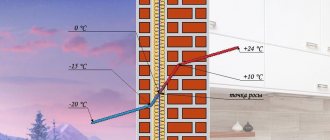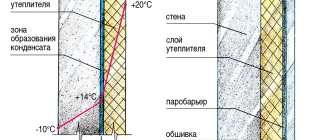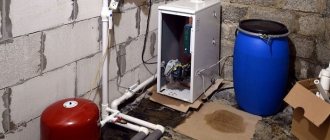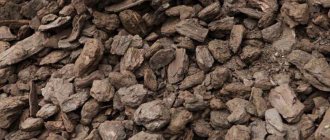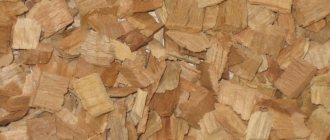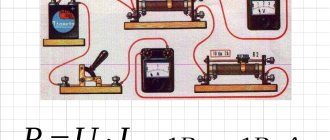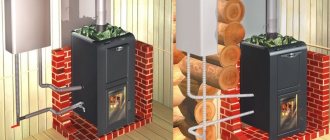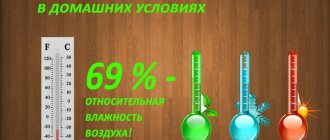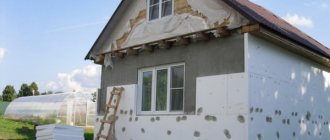Wet grass underfoot, foggy windows, droplets on the walls of a damp basement - all this is the result of condensation of water vapor from the atmospheric air. Everyone has encountered this, but not everyone was interested in how to determine the dew point. Most often, this task has to be solved by architects, builders and designers, and people far from this area are hardly familiar with this concept.
How to determine dew point
The nature of the appearance of dew
Water condensation on various surfaces occurs as follows. Atmospheric air is always saturated with water vapor to one degree or another. Water changes from a gaseous state to a liquid state when its temperature decreases. This occurs when atmospheric air comes into contact with colder surfaces and subsequent heat loss. The result is the appearance of water droplets.
Morning dew is easily explained by the laws of physics
The temperature at which water vapor from the air passes into a liquid state is called dew point .
The higher the content of water vapor in the air (or other mixture of gases), the higher the condensation temperature of water, or dew point. So, with a relative air humidity of 100%, the dew point exactly coincides with its temperature. And vice versa: the lower the relative air humidity, the lower the dew point. This means that for condensation to fall out, you will have to cool the air more.
Studying the dew point in construction
Useful tips
Ventilation must be ensured in such a way that the relative humidity in the home does not exceed normal values (40%-60%). This requires an air flow from outside. In houses and apartments with natural ventilation, it should enter through the cracks in the windows.
But when you replace windows with sealed vinyl windows, there is no air flow. Ventilation does not work, even if the exhaust ducts are equipped with fans. This problem can be solved by installing window or wall valves.
Also make sure there is a gap under the inner door.
Scope of the concept
This term is widely used in industrial and civil construction. The need to determine this value arises when insulating the walls of a room. If you neglect to calculate this indicator, problems will appear after insulation work. One option is damage to the wall finish due to settling moisture. If the finish is tolerant of water, but drops of condensation will fall on the walls, there is nothing good about it either. A humid environment promotes the development of pathogenic microorganisms and mold.
In aviation, dew point is also calculated. During the flight, condensation occurs on some parts of the aircraft. In this case, the condensate freezes and parts of the aircraft become icy.
Ignoring the dew point can lead to a plane crash.
This value is also used in forestry. Forest fire protection specialists use the dew point to calculate the fire hazard class, which characterizes the possibility of forest fires. Based on this, protective measures are designed.
Dew point is used in calculations for planning fire prevention measures
In agriculture, knowing the dew point, the probability of damage to crops by non-infectious diseases (damage caused by weather conditions) is determined. At the same time, one of the tasks of breeding is to develop varieties of cultivated plants capable of condensing moisture from the air on their vegetative organs. This will allow successful farming in conditions of low rainfall.
Dew point placement
Saturated steam, air humidity
We will devote today's lesson to discussing the concept of air humidity and methods for measuring it. The main phenomenon affecting air humidity will be the process of water evaporation, which we already talked about earlier, and the most important concept that we will use will be saturated and unsaturated steam.
If we distinguish different states of steam, they will be determined by the interaction in which the steam is with its liquid. If we imagine that some liquid is in a closed vessel and the process of evaporation occurs, then sooner or later this process will come to a state where evaporation at equal intervals of time will be compensated by condensation and the so-called dynamic equilibrium of the liquid with its vapor will occur (Fig. 1) .
Rice. 1. Saturated steam
Definition. Saturated steam
is steam that is in thermodynamic equilibrium with its liquid.
If the steam is not saturated, then there is no such thermodynamic equilibrium (Fig. 2). Rice.
2. Unsaturated steam Using these two concepts, we will describe such an important characteristic of air as humidity.
Definition. Air humidity
– a value indicating the content of water vapor in the air.
The question arises: why is the concept of humidity important to consider and how does water vapor get into the air? It is known that most of the Earth’s surface is occupied by water (the World Ocean), from the surface of which evaporation continuously occurs (Fig. 3). Of course, in different climatic zones the intensity of this process is different, which depends on the average daily temperature, the presence of winds, etc. These factors determine the fact that in certain places the process of water vaporization is more intense than its condensation, and in some places it is the other way around. On average, it can be argued that the vapor that forms in the air is not saturated, and its properties must be described.
Rice. 3. Evaporation of liquid (Source)
For humans, the humidity level is a very important environmental parameter, since our body reacts very actively to its changes. For example, a mechanism for regulating the functioning of the body, such as sweating, is directly related to the temperature and humidity of the environment. At high humidity, the processes of evaporation of moisture from the surface of the skin are practically compensated by the processes of its condensation and the removal of heat from the body is disrupted, which leads to disturbances in thermoregulation. At low humidity, moisture evaporation processes prevail over condensation processes and the body loses too much fluid, which can lead to dehydration.
The amount of humidity is important not only for humans and other living organisms, but also for the flow of technological processes. For example, due to the known property of water to conduct electric current, its content in the air can seriously affect the correct operation of most electrical appliances.
In addition, the concept of humidity is the most important criterion for assessing weather conditions, which everyone knows from weather forecasts. It is worth noting that if we compare humidity at different times of the year in our usual climatic conditions, it is higher in summer and lower in winter, which is associated, in particular, with the intensity of evaporation processes at different temperatures.
How to calculate dew point
According to the mathematical formula
Carrying out calculations manually using a formula is a fairly accurate method. However, to use the formula, you must first determine several other indicators. The formula looks like this:
Formula for calculating dew point
As can be seen from the figure, a and b are constant quantities. T – air temperature. Rh – relative air humidity. This calculation method will give results with an error of 0.5ºС.
Using an online calculator
Since manual calculation using a formula is not suitable for everyone (due to insufficient knowledge in mathematics or lack of time), online calculators are publicly available on the Internet that calculate the dew point based on the entered information. Using them is absolutely simple: you just need to enter the initial data (ambient air temperature and relative humidity). The result of the calculations will appear on the screen.
Calculator programs
Not everyone can relate the dew point indicator and the expected consequences of improper insulation. This requires specific knowledge in physics and construction. Therefore, in addition to conventional calculators that calculate this value, programs with advanced capabilities have been created. They are also freely available and can be used online.
Such programs take into account many parameters when calculating:
- The locality in which the building was built (is under construction). Statistics of average monthly temperatures, relative humidity, and pressure in this region immediately appear.
- Type of room. Obviously, the air humidity in the bathroom will be higher than in the room, and this in turn affects the type of permissible insulation.
- Construction type. Here you can choose from a wall, ceiling, attic floor and other positions.
- Layers of construction. Here it is taken into account what is located behind the insulated wall - another room or street.
- Floor or wall material.
- Temperature and relative humidity of indoor and outdoor air.
After filling in all the required fields, the program will create a dew point graph.
Dew point determination table
If you need to quickly obtain the dew point value, tables are used. The table data is very inaccurate and gives approximate results. But they are easy and quick to use: you just need to find the desired cell at the intersection of the column and row with the desired temperature and relative humidity.
Table 1. Determination of dew point by two indicators.
Determination of dew point by two indicators
Special tools
In meteorology, special tools have been invented to determine the dew point. However, even to calculate using a mathematical formula or any other method described above, you need your own tools.
Temperature is measured with a thermometer, humidity with a hygrometer. For convenience, in this case, a tool capable of measuring both temperature and air humidity is suitable - a digital thermohygrometer.
This instrument combines the functions of a thermometer and a hygrometer.
In addition, there are devices that combine several functions: measuring temperature, humidity, calculating dew point and storing information.
In most cases, working with such a device looks like this.
- Turn on the device. Pay attention to the battery charge.
This is what one of the popular devices looks like - Place the tip of the sensor at a right angle to the surface under study.
The correct position of the device will ensure accurate measurements - To hold the measurement data, press the Hold button in the menu. This way you can view the results in a comfortable position of the device.
Recording does not mean saving - To save the data, click the Save button.
The ability to save eliminates the need to write data in a notepad - If you need to transfer information to a computer, connect the device to the network via USB.
Connecting a dew point meter to a computer is no more difficult than a mobile phone - Copy the data to your computer.
Computer – reliable data storage
Working with devices for measuring dew point is simple even for a person without special training. The interface is intuitive, and if you have any questions, please refer to the instructions.
Formula for calculation
The following formula will help you calculate the dew point yourself and accurately:
This formula can be used to calculate relative humidity from a known dew point
Here Tr means the temperature of the point itself, b and a show equal (constant) values, ln is the natural logarithm, T is the indoor temperature, Rh is the relative humidity value.
As can be seen from the formula, the value directly depends on the values of two parameters:
- humidity indicator;
- actual temperature readings.
At high relative humidity, the parameter becomes higher and closer to the actual temperature level. To calculate this variable value, there is a table with a small step of parameters. From it you can find the required value by measuring the relative humidity and actual temperature.
We recommend reading: How to install a toilet on tiles with your own hands: step-by-step instructions
Table 1. Determination of the indicator using the ratio of influencing parameters on which the dew point depends
From the table we calculate that at a temperature of, for example, 19 degrees and a humidity of 50%, the condensation parameter will be 8.3 degrees.
From this video it becomes clear how thick the insulation should be for the most comfortable conditions:
Precise definition
Water vapor most often condenses on the walls themselves or inside their structure if they are not insulated or built properly. Without insulation, the value will be close to the temperature of the inside of the wall, and in some cases, the wall in the middle of the house. When the temperature inside the enclosing structures is below this value, condensation will occur during a cold snap at negative temperatures outside.
There are several places where the indicator may be located on non-insulated structures:
- inside the structure, close to its outer part, the wall will remain dry;
- inside the wall, but close to the inside, the wall becomes wet with temperature changes;
- the side of the wall that is located in the building will constantly be covered with condensation.
Experts do not recommend insulating rooms from the inside, explaining that when using this method of thermal insulation, the parameter will be located under the heat-insulating layer in the middle of the room . As a result, a large accumulation of moisture will occur .
- condensation can accumulate in the center of the wall and, during cold weather, move towards the placement of heat-insulating components;
- the place where moisture accumulates can be the boundary of the enclosing structure and the insulating layer, which becomes damp and forms mold in the middle of the rooms;
- in the middle of the heat-insulating layer itself (it will gradually become saturated with moisture and begin to mold and rot from the inside).
The dew point is formed by three components: atmospheric pressure, air temperature and humidity.
Polystyrene foam, mineral wool or other type of insulation must be placed on the outside of the building , which will allow the value to be placed in the insulating layer (with this arrangement the walls inside will remain dry). For a clearer understanding of the parameter, there are graphs for its placement on the walls of houses with insulation, as well as on buildings that do not have an insulating layer. To make this calculation yourself, you can determine the dew point in the wall with a calculator.
The importance of determining dew point
If you do not take into account the position of the dew point in the wall, a series of negative events will follow.
The insulation material quickly becomes unusable, and the service life of the wall material itself is reduced. Due to regular wetting, the finish will not hold up: the wallpaper gradually peels off, the plaster crumbles, and the paint peels off. Due to excess humidity in the room, mold, mildew and other pathogenic microorganisms develop in a short period of time on walls, ventilation systems, ceilings and other surfaces.
Ignoring the physical nature of condensation can lead to unsanitary conditions in the room
Condensation hygrometer
As can be seen from the formula, it includes absolute humidity, with which we are already familiar, and saturated vapor density at the same temperature. The question arises: how to determine the latter value? There are special devices for this. We will look at condensation hygrometer
(Fig. 4) is a device that is used to determine the dew point.
Definition. Dew point
– the temperature at which steam becomes saturated.
Rice. 4. Condensation hygrometer (Source)
An easily evaporating liquid, for example, ether, is poured into the container of the device, a thermometer (6) is inserted, and air is pumped through the container using a bulb (5). As a result of increased air circulation, intensive evaporation of ether begins, the temperature of the container decreases because of this and dew (droplets of condensed steam) appears on the mirror (4). At the moment dew appears on the mirror, the temperature is measured using a thermometer; this temperature is the dew point.
What to do with the obtained temperature value (dew point)? There is a special table in which data is entered - what density of saturated water vapor corresponds to each specific dew point. It is worth noting a useful fact that as the dew point increases, the value of the corresponding saturated vapor density also increases. In other words, the warmer the air, the greater the amount of moisture it can contain, and vice versa, the colder the air, the lower the maximum vapor content in it.
How does dew behave on uninsulated walls?
With uninsulated walls, there are several variations in the behavior of the dew point. In some situations, it is located in the inner space of the wall - closer to the street or closer to the room. In the second case, with a strong decrease in temperature, the place of steam condensation will shift to the inner surface of the wall. Then drops of condensation will certainly form on its surface.
Uninsulated walls often get wet
In some cases (cold building frame material), the dew point can be located indoors all year round, that is, on the inner surface of the wall. Then it is necessary to make applied calculations and take care of the insulation of the wall, taking into account the climatic characteristics of the locality in which the building is located.
In general, the location of the dew point in a ceiling or wall is interconnected with a number of physical factors:
- humidity of outdoor air and indoor air;
- outdoor and indoor air temperatures;
- thickness of the ceiling or wall.
Relative humidity
To describe this perception, a quantity such as relative humidity
.
Definition. Relative humidity
– a value indicating how far the steam is from saturation.
That is, the value of relative humidity, in simple words, shows the following: if the steam is far from saturation, then the humidity is low, if it is close, it is high.
Relative humidity symbol
:
.
Relative Humidity Units
: %.
Formula for calculating relative humidity
:
Designations:
water vapor density (absolute humidity), (in SI) or ; density of saturated water vapor at a given temperature, (in SI) or .
Dew point in externally insulated walls
With the correct selection of material and correctly calculated thickness of the insulating layer, the dew point will always be in the insulation and will never move towards the inner surface. The walls are dry all year round. Only the insulation is damaged by weather conditions; the wear of the walls slows down.
External insulation is the surest protection against condensation in the apartment
If the thickness of the insulation is less than required, or the thermal conductivity of the material has not been taken into account, the dew point will behave in the same way as in an uninsulated wall, that is, moisture will continue to accumulate in the room if it accumulated before insulation. If this happens, there is only one way out - to increase the thickness of the insulating material. This can be done by adding another layer of thermal insulation or replacing the old material with a new one of suitable thickness.
If the insulating layer is excessively thick, the dew point will not go beyond its limits throughout the year. This will not entail any negative consequences: the wall will be dry all year round. However, calculations are made in order to avoid unreasonable financial expenses. After all, if you can escape moisture and retain heat with less insulation, then why spend more?
Should I insulate the walls inside or outside?
Publications
- How do synoptic swings affect meteorologists?
Natalya Didenko ForecasterWeather and health January 26 14:06
- Natalya Didenko Forecaster
How winter cold affects the human body
Weather and health January 25 14:06
- Natalya Didenko Forecaster
How to prepare for a hike in the mountains in winter
Weather and health January 24 18:06
- Natalya Didenko Forecaster
The new week in Ukraine will show from -18 to +5 degrees
Weather in Ukraine for tomorrow January 24 14:00
- Igor Kibalchich Forecaster
Equatorial climate zone (rain forest climate)
Interesting facts about the weather January 24 09:53
Dew point in internally insulated walls
Insulating walls only from the inside inevitably leads to a shift in the dew point towards the room. This happens because the thermal insulation material retains heat in the room, thereby making the wall colder. And, as you know, the colder the surface, the more likely it is that air moisture will condense on it.
If at normal temperatures for a given region the dew point is located close to the inner surface of the wall and does not cause any inconvenience, then on particularly cold days it can move into the room, that is, onto the inner surface of the wall. Then the wall will get wet under the insulation.
If moisture constantly accumulates on an uninsulated wall, then after work on the internal insulation of the room, the wall will continue to get wet under the insulation throughout the cold season. This will lead to gradual deterioration of all layers of building materials located on the inside of the wall, including the finishing.
Internal insulation does not protect against getting wet
In some cases, after internal insulation of a normal wall, the dew point changes location to the insulation. Then, throughout the winter, not only the wall will be wet, but also the thermal insulation material itself.
One way or another, in order to avoid damage to the finish and internal insulation layers, you need to remember one simple rule: insulation of the inner surface of the wall is carried out only after its external insulation.
Factors influencing heat loss
Thermal processes correlate well with electrical processes: temperature difference acts as voltage, heat flow can be thought of as current - there is no need to create a special term for resistance. The concept of least resistance, called thermal bridges in heating engineering, is also completely correct.
If you consider any material in cross section, it is quite easy to determine the path of heat flow at both the micro and macro levels. As the first model, we will take a concrete wall in which, due to technological necessity, the through fastenings are made with steel rods of arbitrary cross-section. Steel conducts heat slightly better than concrete, so three main heat flows can be distinguished
- From steel bars to concrete
- Through the thickness of concrete
- Through the steel bars
Heat loss through thermal bridges in concrete
The most interesting model is the final heat flow. Because the steel core heats up faster, the temperature difference between the two materials will occur closer to the outside of the wall. Thus, the steel not only “pumps” heat out itself, but also increases the thermal conductivity of the adjacent concrete masses.
Thermal processes in porous media proceed according to a similar pattern. Almost all building materials consist of an extensive network of solid materials, between which there is a space filled with air. Therefore, a solid, dense material is the main conductor of heat, but due to its complex structure, the path along which heat moves is larger than its cross-sectional area. Therefore, the second factor determining thermal resistance is the heterogeneity of each layer and the entire building envelope.
Reducing heat loss and shifting the dew point in the thermal insulation of external walls
About the dew point in plastic windows
When it comes to the dew point in double-glazed windows, many people imagine some specific mysterious place. In reality, the dew point cannot be seen, as we have already found out. Let us repeat: dew point refers to the temperature at which, when cooled, the vapor in the air becomes saturated and condenses. There are special tables that allow you to calculate the dew point at relative humidity and a specific temperature. One such table is shown below.
Dew point at relative humidity
On a note! Let’s say the air humidity is 50% and the temperature is +21 degrees. Under such circumstances, the dew point will be +10.2. What does it mean? If the temperature of any surface in the apartment drops to +10.2 degrees, then condensation will begin to appear on it (the surface). As a rule, the coldest surfaces in the apartment are plastic windows, and therefore it is on them that in most cases excess moisture falls.
People often experience condensation on double-glazed windows. Based on everything said above, we can conclude that condensation can be dealt with in two ways - by increasing the temperature of the glass and reducing the humidity in the apartment. Thus, comfortable humidity can be achieved by ensuring normal air exchange. All excess moisture comes from washing, boiling pots, etc. – should leave the room and not accumulate in it. First of all, the apartment should be regularly ventilated. The frequency of ventilation is determined individually, but we recommend doing this for at least 10 minutes twice a day. Don’t forget about special supply ventilation valves.
Examples
Another simple example can be considered when something is brought into a warm room from the cold. The air above it cools, becomes saturated with water vapor, and water droplets condense on things.
Subsequently, the item warms up to the room temperature and the condensation evaporates. By the way, this phenomenon determines the recommendation not to immediately plug in household electrical appliances brought in from the cold.
Another, no less familiar example is fogging of glass in the house. Many people have windows that “cry” in winter; condensation falls on them. It is necessary to understand that this phenomenon is largely influenced by two factors - humidity and temperature.
Therefore, if you have a normal double-glazed window and proper insulation, but there is condensation, it means that not everything is in order with humidity; Possibly poor ventilation or exhaust.
One of the most interesting physical phenomena is a change in the state of aggregation of water, in particular the boiling of water. Read more detailed information in the article The boiling point of water is really very interesting. We are sure that you will find a lot of new things for yourself here.
You can read everything about breaststroke swimming in this article; it’s time to take care of your health right now!
Hair hygrometer
Let us now consider the principle of operation of other types of hygrometers, instruments for measuring humidity characteristics (from the Greek hygros - “wet” and metreo - “I measure”).
Hair hygrometer
(Fig. 5) is a device for measuring relative humidity, in which hair, for example human hair, acts as an active element.
Rice. 5. Hair hygrometer (Source)
The action of a hair hygrometer is based on the property of defatted hair to change its length when air humidity changes (with increasing humidity, the length of the hair increases, with decreasing it decreases), which makes it possible to measure relative humidity. The hair is stretched over a metal frame. The change in hair length is transmitted to the arrow moving along the scale. It should be remembered that a hair hygrometer does not give accurate relative humidity values, and is used primarily for domestic purposes.
Psychrometer
A more convenient and accurate device for measuring relative humidity is a psychrometer (from the ancient Greek ψυχρός - “cold”) (Fig. 6).
Rice. 6. Psychrometer (Source)
A psychrometer consists of two thermometers, which are fixed on a common scale. One of the thermometers is called a wet thermometer because it is wrapped in cambric fabric, which is immersed in a reservoir of water located on the back of the device. Water evaporates from the wet fabric, which leads to cooling of the thermometer, the process of reducing its temperature continues until the stage is reached until the steam near the wet fabric reaches saturation and the thermometer begins to show the dew point temperature. Thus, the wet bulb thermometer shows a temperature less than or equal to the actual ambient temperature. The second thermometer is called a dry thermometer and shows the real temperature.
On the body of the device, as a rule, there is also a so-called psychrometric table (Table 2). Using this table, you can determine the relative humidity of the surrounding air from the temperature value shown by the dry bulb thermometer and from the temperature difference between the dry and wet bulb bulbs.
However, even without such a table at hand, you can approximately determine the amount of humidity using the following principle. If the readings of both thermometers are close to each other, then the evaporation of water from the humid one is almost completely compensated by condensation, i.e., the air humidity is high. If, on the contrary, the difference in thermometer readings is large, then evaporation from the wet fabric prevails over condensation and the air is dry and humidity is low.

